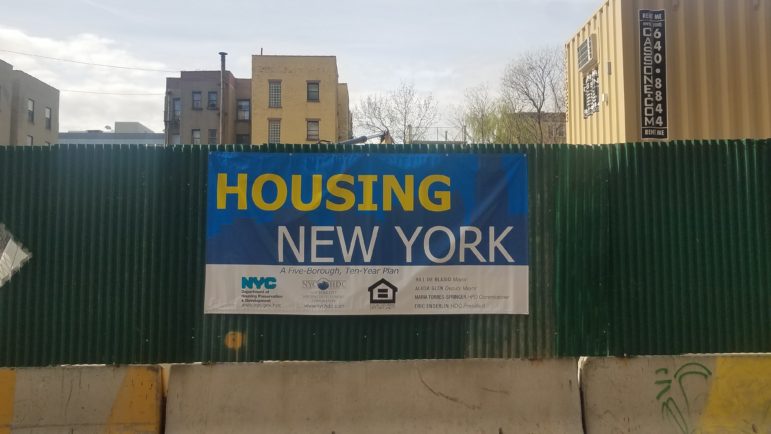
Fifty-one years after the passage of the Fair Housing Act of 1968, New York City remains one of the most segregated major cities in America. Meanwhile, as Bill de Blasio is the latest in a string of mayors using incentives to get private developers to build purportedly affordable housing, the pervasive question among city residents and community advocates is, “affordable for whom?” Indeed, these are twin problems, but the Fair Housing Act, lying in plain sight, is an under-discussed tool that may provide redress for both.
In short, the household income targets that de Blasio’s plan, called Housing New York, envisions for the housing it produces skews disproportionately toward more firmly middle class households; these targets ignore the gulfs in household income between white households and Black and Latino households citywide. City-wide, the median white household earns about $80,000, while the median black household earns just under $43,000 and the median Latino household earns under $38,000. Under the plan, almost as many homes are targeted for households in what are called moderate- and middle-income households—the latter category of which includes three-person households earning up to $125,000—as are targeted to what are called very low- and extremely-low income households, which earn less than about $43,000 for a three-person household. Although a majority (55 percent) of the units produced under the plan are targeted to what is called low-income households, which range from about $43,000 to about $69,000 for a three-person household, the median black and Latino households earn too little to qualify for this housing, to say nothing of the more expensive housing produced under the plan. This analysis holds even truer in most of the neighborhoods targeted for re-zonings under the Mandatory Inclusionary Housing program, which includes some of the city’s poorest and most heavily black and Latino neighborhoods.
To boot, the units produced Housing New York will be geared sharply toward households that look more like the largely young, white residents moving to the city and less toward households that look like many of the city’s black and Latino households. Black and Latino households in New York City skew younger and larger, and there is a modestly greater frequency of single-parenthood (and thus a greater likelihood that there is one breadwinner in the household). However, many of the younger white newcomers live in nonfamily households without children—that is, as roommates or unmarried couples. Accordingly, the city has indicated its intention to the U.S. Department of Housing and Urban Development to incentivize the construction of more studio and one-bedroom apartments while steering developers away from producing more two- and three-bedroom apartments. Although the city has justified this shift by pointing to a purported increase in the number of nonfamily households in the city, the number of nonfamily households has remained flat citywide, increasing largely in gentrifying neighborhoods, while the largest-share of rent-burdened, single residents is senior citizens, not young adults.
These policies already have adverse effects, to use the language of fair housing law, on black and Latino New Yorkers and perpetuate segregation by locking these New Yorkers of color out of the developments where Housing New York units are produced. The city’s oft-discussed community preference policy, currently being challenged in Noel v. City of New York, further compounds these segregative effects. When looking for affordable housing outside of their current neighborhoods, lower-income, disproportionately black and Latino New Yorkers are severely disadvantaged by the policy; and within these neighborhoods, the policy’s lack of additional requirements (such as length of residency) makes it an inadequate safeguard against gentrification. Meanwhile, housing produced for middle- and moderate-income households, who are disproportionately white, are priced close to market-rate housing, and the city has encountered difficulty in leasing those units.
Despite New York City’s deeply entrenched housing market, city government has recourse to resolve these issues. It can reduce or eliminate the community preference policy, which, notwithstanding the potential outcome of the current legal challenge, City Council Speaker Corey Johnson has expressed an openness to pursuing. It may also boost financing of its programs to support housing for extremely low- and very low-income households, which can be paid for by a more progressive real property transfer tax structure, as Comptroller Scott Stringer has proposed. Lastly, the de Blasio administration should have the courage to begin MIH re-zoning processes in the city’s wealthiest neighborhoods; the city’s own analysis shows that doing so in these vibrant real estate markets makes it more economically feasible to subsidize affordable housing for the poorest New Yorkers, instead of spending tens of millions of dollars to boost weaker markets in the poorer neighborhoods the city has upzoned in recent years.
The usefulness and equity of a plan that fails to serve the poorest New Yorkers come deeply into question. The de Blasio administration has had the tools at its disposal to produce more deeply affordable housing for New York City’s poorer residents, who are disproportionately black and Latino. Its longstanding failure to seize this opportunity means that it is time for advocates to use the litigation as a tool toward this end.
Pablo Zevallos (@PabloZevallos) is a third-year student at Columbia Law School. This piece is adapted from his forthcoming article, “A Statement About Who Deserves to Live Here”: The Fair Housing Act Implications of Housing New York, which will be published in the Summer 2019 issue of the Columbia Journal of Law and Social Problems.









2 thoughts on “Opinion: De Blasio’s Housing Plan is Neither Affordable Nor Fair”
Pingback: Opinion: De Blasio’s Housing Plan is Neither Affordable Nor Fair - SustainableHousing
Pingback: Opinion: De Blasio’s Housing Plan is Neither Affordable Nor Fair – City Limits | LatinoSearch.biz